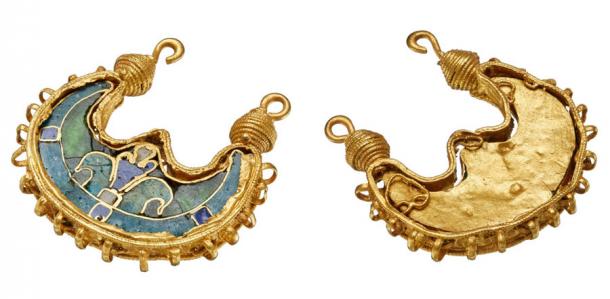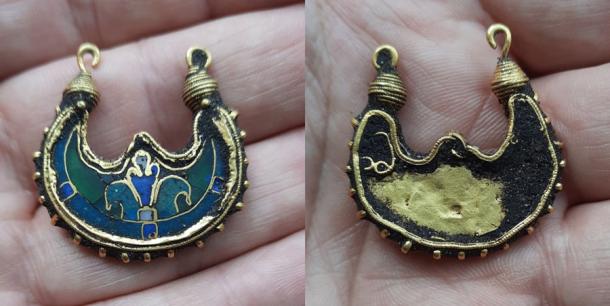The National Museum in Copenhagen announced on Sunday that 54-year-old Frants Fugl Vestergaard from Denmark unearthed a rare gold earring while metal detecting in a field in West Jutland. Believed to be an 11th century gift from the Emperor of Byzantium to a Viking chief, the earring is built around a crescent-shaped gold plate. Inlaid with enamel in a frame of golden threads, the gold earring is decorated with small gold balls and gold bands. The motif on the gold plate depicts two stylized birds on either side of the tree of life.

Frants Fugl Vestergaard unearthed the rare gold earring while metal detecting in a field in West Jutland. ( Nationalmuseet)
Gold Earring as Bodyguard’s Payment?
According to an article in Spiegel, National Museum experts are “puzzled” as to how the gold earring got to where it was recently dug up. The 1,000-year-old earring is most likely from the Middle East , and therefore it represents “the first discovery of such an object in Scandinavia.” The museum researchers also said that “the 1,000-year-old rare artifact may provide an archaeological breakthrough in the understanding of Vikings and the Middle East.”
So rare is the gold earring that only 12 similar artifacts have ever been found, anywhere. Museum expert Peter Pentz said the earring originated in Byzantium or Egypt, and that it was “likely a gift from the emperor of Byzantium to a Viking chieftain.” However, it was considered whether the emperor of Byzantium had maybe given the earring to a Danish Viking, who perhaps served as a personal bodyguard.

Front and back of the rare gold earring discovered in West Jutland, Denmark. ( Nationalmuseet)
A Dream Viking Discovery
In the mid-7th century, people in Denmark, Norway and Sweden began invading the British Isles. In the 8th century they extended their territory and plundered the coasts of Ireland, the Faroe Islands, Iceland, Greenland and Normandy, while expanding eastwards along the Baltic coast. Known as Varangians, they also invaded Dnieper and Volga trade routes in eastern Europe.
Even though the Vikings brought gold and silver coins, as well as other raided treasures from coastal villages, towns and monasteries, back home en-masse, TV Midwest reported that Pentz explained that “it was rare to find jewelry among their loot.”
Not only are the origins of the earring a mystery, but so too is the story of how it got to be buried in West Jutland. Adding to the uncertainty, Pentz said there are no known Viking sites anywhere near the find site. For all these reasons Frants Fugl Vestergaard, also from the Copenhagen Museum, concluded that this discovery “was a dream.”

Image showing front and back of the rare gold earring which originated in the Middle East. ( Nationalmuseet)
Middle Eastern Treasures Were Otherworldly Tools
A 2015 CNN article discussed the discovery of an ancient finger ring that was also said to shed new light on “the ties between Vikings and the Islamic world.” This ring was discovered in the town of Birka, on Björkö island, during a late 19th century excavation of a 9th century female Viking grave . Just 19 miles (30 kilometers) from Stockholm, this ring is inscribed with the letters “AL_LLH” (Allah) in Arabic Kufic writing. In a paper published in the journal Scanning, the researchers said this was “the only ring with an Arabic inscription ever found at a Scandinavian archaeological site.”
Like the recently discovered gold earring, the researchers concluded that this finger ring had “never been worn.” This suggests Middle Eastern jewelry was among the Vikings most valuable treasures, and that the Viking Age elites who owned these objects dared not wear them, perhaps fearing their loss.
The other thing that becomes apparent, as with the finger ring which was also discovered in a Viking grave , is that these leaders of the Scandinavian warrior classes made sure they were buried with these treasures. This suggests rare rings, like weapons, were imbued with supernatural powers and were regarded as important tools in the journey to the afterlife.
Top image: The 1,000-year-old Middle Eastern gold earring was found in in Denmark. Source: Nationalmuseet
By Ashley Cowie
 RSS Feed
RSS Feed















 December 10th, 2021
December 10th, 2021  Awake Goy
Awake Goy  Posted in
Posted in  Tags:
Tags: 













